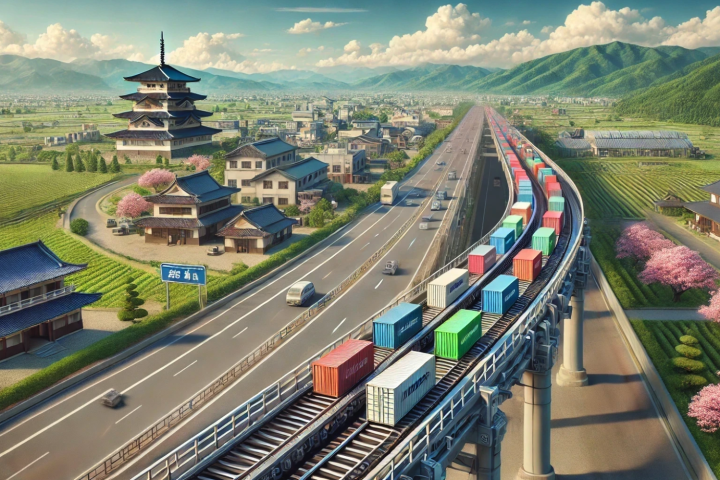One of the more remarkable technological innovations amongst hundreds currently on display at World Expo 2010 in Shanghai can be found in the Japanese Pavilion where major sponsors Canon, Panasonic and Toyota are all showing their visions of the future. Most of it we've seen before, but Canon's "Wonder Camera Concept" is entirely new – it's the camera of the future visualized twenty years hence by the world's largest camera company and it is incredibly thought-provoking.
Shanghai Expo 2010
Now if you can get to the Expo, which runs until October, you should, because it is the greatest show on Earth in the showcase city for the country which is rapidly emerging into the world's first megapower.
Firstly, World Expos have been getting smaller in recent times – many consider the concept is past its use-by-date due to the prohibitive cost of staging one and the growing reach of the Internet in propagating new thought, which is what Expos have always done best – spread new and better ideas globally.
Nonetheless, in staging the Shanghai Expo 2010, China is footing the bill for the most expensive event in history... other than wars. The Expo has cost China a staggering US$60 billion dollars – no other country could have built something of this scale for a host of reasons. It's a story in itself and will be the subject of an upcoming article.
Many people are saying that grand ideas and new technologies are no longer being debuted at events such as the World Expo. This isn't true. There are myriad technologies at Expo 2010 but in creating an event of such grandiose scale, China has actually done itself a disservice because the foreign media just couldn't easily do the 60 second TV grab. The event is 20 times larger in size than the previous World Expo in Spain – it's twice the size of Monaco. Getting around the site requires a lot of walking and carrying camera equipment and standing in queues. It might take three months to fully see all the things the Expo has to offer, such is its vastness. Perhaps the real reason the Expo is not getting recognized for the hotbed of innovation that it is, is because the foreign media with access to Shanghai is not technology-based.
Ideas that have propagated globally after being exposed at world fairs include the aeroplane, telephone, fax, electric lighting and the diesel engine. Other notables to go on show for the first time include the Ferris wheel, the zipper, Eisteddfod musical competition, the icecream cone, hot dog, iced tea, peanut butter and the hamburger.
The latest World Expo in Shanghai has a theme of urban living – Better City, Better Life. The focus of this event is hence largely on sustainability, and green technologies are on show in abundance because it's fast becoming obvious that if three quarters of the world's people are to live on top of each other in cities, as will be the case in less than 100 years, we're going to need to be far more respectful of the environment and tread far more lightly on Mother Earth than ever before – one of the messages from Expo 2010 is that sustainability is now an imperative.
US$140 million Japanese pavilion
There are though, a few hero technology products hidden amongst the massive Shanghai expo site and one that stands out is Canon's Wonder Camera Concept on show at the US$140 million Japanese pavilion. The Japanese pavilion is another upcoming story, as it's essentially a living breathing building, but it contains dozens of new technologies on show for the first time.
In the consumer category, Toyota is displaying its i-REAL Personal Mobility device and one of its forthcoming series of partner robots and Panasonic is demonstrating its Lifewall, but none of those things are really new, all having been displayed at previous international technology exhibitions over the past two or three years
We first saw the Panasonic Lifewall concept a few years back, and it is continually evolving. The backdrop to the stage where the Canon Wonder Camera is being demonstrated is made up of three multi-touch Panasonic 152 inch plasmas running at 4K2K to form an interactive touch wall measuring 10.28 metres (33.6 ft) by 1.8 metre (5.9 ft). As each of the screens is running at 4K2K (4096 x 2160 pixels), the screen is 12,288 pixels wide and 2160 pixels high. The screens are raised from ground level about a foot (30 cm), so the overall effect is spectacular – if it wasn't for the fact that the retail price of these screens would probably be US$500,000 each, I'd be wanting one now.
Canon Wonder Camera concept
Star of the Show
What was new, and was undoubtedly the star of the show, was the Canon Wonder Camera, one of the first times we've ever seen a "concept camera" – concepts are usually restricted to car industry where an eye-catching shape is enough, along with a few flashing lights, to convey what the benefits of such a device might be and assess from public and media reaction whether it could become a commercially viable offering.
Even in the automotive marketplace which has a tradition of showing new ideas long before they might ever be considered as viable product, many concept cars are dumb – they don't actually do what they are envisioned to do because the technologies aren't available yet.
But the Internet has rendered distance irrelevant and the world is quickly getting much smaller due to the network, and hence speeding up commercial activity at the same time. Concept to market times are now measured in months rather than years, so it's understandable that world expos might no longer have the number of landmark fully-formed products and concepts they once had.
The rate at which digital cameras are progressing in capability is perhaps even more breathtaking than computers – seemingly each month the form factor for any given category gets smaller, while resolution and zoom get larger, there are new and better and more image stabilization technologies, more intelligent algorithms and more processing power to fix human error and storage capabilities are rapidly progressing towards effective infinity. Maybe only battery technology is lagging behind in this area – as a traveling journalist I carry more batteries than memory cards these days because I'm far more likely to run out of battery than memory space.
The camera is also becoming an increasingly meaningful new node on our personal networks because it records what we see, where we've been and what we do, so it's a natural for capturing and disseminating information, images and video.
The Wonder Camera is Canon's vision and ALL those same aforementioned trends are evident, extrapolated to outrageous levels.
What I found most staggering of all, was that most of the technologies envisioned actually appeared to work, or had been synthesized so they appeared to work so that we could see what the future might hold.
Those technologies are all part of the Wonder Camera: still image and video imaging are combined – with such massive resolution, you can simply pick out the exact still image you want at any time, because Canon claims to have a proprietary technology that enables everything in every frame to be in focus at all times.
As I spent the entire presentation handholding a video camera with image stabilization technology, and struggled to keep it steady enough from my distant vantage point at long focal lengths – journalists were restricted to the back of the room and hence I was around 25 meters from the stage – I couldn't help but wonder what the image stabilization technologies of the future might be. Despite spectacularly long zoom lens images – maybe 3000 mm to 5000 mm – which were being demonstrated, the images on on the screen of the Wonder Camera were very stable.
Everything, in every frame, in focus
With video capturing everything in perfect focus, and over time becoming cheaper and all pervasive, will still image photography become democratized and immensely popular, or redundant? If the algorithms of a camera such as imagined by Canon's concept capture perfectly exposed images in perfect resolution at all times, then every frame of every video will contain countless perfect still images. Will the law of supply and demand devalue the currency of professional still image photographers? Should wedding photographers start upskilling now if a camera such as the Wonder Camera can make capturing perfect renditions of reality within the skills of anyone?
Will still photography become an irrelevant artifact of artistic endeavor whose time has come and gone because something better and easier has come along – like calligraphy – everyone has a pen and paper, it's just that no-one does it anymore because we've found a different way to communicate.
Impractical skillsets tend to be deemed unnecessary and ultimately worthless.
The vision of the Wonder Camera means you can zoom in now, or later to see what you've captured, and every time you depress the button, you're capturing a seemingly infinite amount of information. While I watched the camera being demonstrated, I couldn't help but think that it must be capturing and storing a very large amount of information – but with storage capacity following the same exponential bang per buck trends as Moore's Law, it's entirely plausible that two decades down the track we'll have such a device with a resolution we cannot currently imagine and more than enough storage space. In 20 years time, a terabyte or a petabyte will be as inconsequential as a megabyte is today and a kilobyte once was.
Now the videos shown in the pavilion present a stand-alone camera with wireless networking, so I was more than happy to suspend disbelief when the camera was demonstrated on stage by a girl wearing a backpack the size of a laptop with leads running to the camera. Given that the capabilities being demonstrated are set 20 years into the future, and they were demonstrated very convincingly, and that Canon had actually shown some of its IP in forecasting what it thinks the product of the future will look like, I am amazed that this whole exercise ever took place as it gives everyone else a target technology to aim for.
Canon is the world's largest camera company. Two years ago Nokia, the world's largest mobile phone manufacturer claimed it was the largest camera manufacturer in the world because its mobile phones included more cameras, in units, than any other.
With cameras now standard fare on every mobile phone, the camera as we know it will become an endangered species and Canon clearly needs to differentiate its camera offerings well beyond what can be easily added to a mobile phone with an autofocus lens and a sensing chip – the wonder camera does just that and at the same time raises the bar for Nikon, Olympus, Hasselblad, Casio, or Sony.
Not surprisingly, very little information and no specifications were available – it's a concept camera – but in essence, the "Wonder Camera" being demonstrated offers both still image and video imaging combined in a unibody form factor around the size of a digital SLR. It shoots at massive resolution, well beyond anything we currently know, with a single zoom lens which caters for all circumstances, from macro to megazoom. Everything is in focus at all times and you can zoom in several orders of magnitude beyond anything we currently know. The massive resolution of the camera was demonstrated on several occasions during the show – taking a still image and zooming in on a very small and quite distant object in that wide vista to reveal incredible detail.
From one image taken by the camera, the presenters on stage plucked dozens of portraits of people in the audience, using the camera's image recognition capabilities to capture just those people who had smiled.
In many ways, it is more akin to a television broadcast camera in its zoom capabilities, but without the need for a lens the size of a bazooka or a tripod for added stability. Though this is clearly a consumer-level camera being visualized two decades from now, it would seem that the SLR and interchangeable lens concept that has been the mainstay of professional photography for 50 years might be in for a rethink because there's clearly no need for anything more than the wonder camera with its effectively infinite zoom and resolution.
The Canon Wonder camera was also networked and capable of high wireless speeds. intelligent post-production and high-speed networking capabilities tending towards the capabilities of an outside television broadcast van.
Vision of the future
Canon's choice of venue for showing such a groundbreaking concept is also telling. China is getting rich quickly, and with the world's largest population – 1.4 billion in round numbers – is quickly overhauling all other markets to become number one. It now has twice as many Internet users as the United States, lifted the mantle of the world's largest auto market from the United States last year and is expected to become the world's largest camera market in 2015.My bet is that we'll see a camera like the Wonder Camera much sooner than two decades – when the world's largest quality camera company goes to the trouble of articulating what it believes will be the camera of the day two decades from now, you can guarantee that it'll be out in possibly half that time.
Which then had me thinking – how will the camera companies differentiate their product when we get to this stage? More than enough resolution, with everything in focus at all times, zoom capabilities tending towards infinite - what's next?


















































